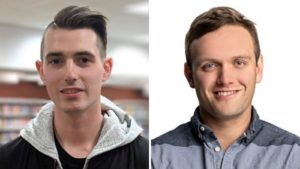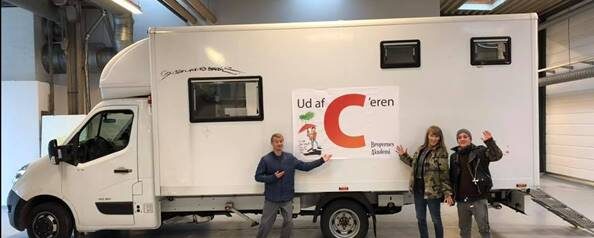26 February 2023
INHSU’s Early-Mid-Career-Researcher Special Interest Group (INHSU EMCR), held a webinar last year, discussing the integral relationship between community and academics, and how to ensure it’s meaningful, mutually beneficial, and as far from tokenistic as possible.

In the session, we heard from Matthew Bonn, program manager at the Canadian Network of People Who Use Drugs (CAPUD) and Tommy Brothers, a physician and General Internal Medicine fellow at Dalhousie University, Halifax. Both are also researchers. The pair first met in 2017 and worked together on advocacy for a supervised consumption site, and their collaboration and (heartwarming) relationship has grown from strength to strength since then.
Their joint accomplishments include the establishment of Halifax’s first-ever supervised consumption site, multiple shared speaking opportunities at events across the world, numerous co-authored papers, endless media opportunities, and multiple successful joint grant applications.
Their relationship truly exemplifies what can be achieved when a meaningful partnership is made between healthcare providers, academics, and community members. Below we discuss five key takeaways from the session, but truthfully this only skims the surface. We would thoroughly recommend taking the time to watch the full session.
Thank you to Brendan Harney and Anna Conway for facilitating the session. Join INHSU EMCR here.
-
Academics can advocate for community in all areas of their work
One of Tommy and Matt’s early achievements was to involve Matt in a panel at a conference for addiction medicine providers in 2019, speaking about safe supply.
In a room full of traditional methadone prescribers, having Matt speak about real, lived experience introduced a whole new perspective on a subject that many in the room had strong views against. It enabled real conversations to happen that otherwise may not have.
The opportunity came as a result of Tommy volunteering on the conference’s Conference Committee and advocating for the need for a community voice, integrated in a meaningful way.
-
Embrace the creativity that community brings
Some of Matt’s first published academic work came as a result of speculative communication with various journals regarding the potential of a Letter to Editor on the topic of safe supply.
Although the format of Letter to Editor was turned down by the journals, the Journal of Studies of Alcohol and Drugs asked Matt to expand it into a 2,000-word commentary, which he did in collaboration with Adam Palayew, Sofia Bartlett, Tommy Brothers, Natasha Touesnard, and Mark Tyndall.
This was an opportunity that would not have arisen if it wasn’t for Matt’s creative thinking when it came to journal submissions.
Addressing the Syndemic of HIV, Hepatitis C, Overdose, and COVID-19 Among People Who Use Drugs: The Potential Roles for Decriminalization and Safe Supply has since had 86 citations and multiple published responses.
It even led to a $50,000 grant from the Canadian Institutes of Health Research for a rapid scoping review project on how safe supply might be facilitated in response to the COVID-19 pandemic.
-
Social media and non-academic publications offer new opportunities
As well as a powerful advocate for harm reduction and safe supply, Matt is also a published journalist for major drug-related publications and magazines including Filter and Talking Drugs. He’s also very active on social media.
Publications like these, and social media, provide a valuable opportunity to increase the reach of academic research and disseminate it to advocates, policymakers, and other changemakers in a way that’s more accessible for non-academics.
As Matt says, every time there’s a commentary in a journal, make more accessible content for other publications and build relationships with journalists. Tommy has learned a lot from Matt about communication and now takes proactive steps such as reaching out to university press offices with new papers for potential media blasts to their contacts.
Don’t underestimate the power of a researcher and community partnership. Journalists want both perspectives of a story, and you give them both in a nice tidy package.
-
Value each other’s perspectives
One of the most poignant moments of the session was when Matt shared a photo of his first-ever INHSU conference in Montreal in 2019.
I had two posters that were accepted, including one about a provincial prison outreach program I was leading that was aimed at reducing HIV, hepatitis C or other drug-related harms. This moment just shows that you can acknowledge me as a peer or someone who uses drugs, or you can include me into projects and other opportunities.
The reason Tommy and Matt’s relationship works so well is because it has gone far beyond just academic research. They are peers in every sense and value and respect each other’s perspectives and experiences. This has led to multiple new opportunities to work together, and perhaps more importantly, a lasting friendship.
Matt and I have different backgrounds and different life experiences. And we bring different perspectives to the table. But we share a lot of values, enjoy working on these projects together, brainstorming and looking for opportunities, and ultimately making things happen.
-
Pay community fairly
One of the emerging themes from the INHSU 2022 Community Day (separate to this webinar) was the need to pay peers for their contribution and work. Matt is now involved in Tommy’s PhD team, with funding sought to ensure his contribution was fairly compensated.
“Matt is really intimately involved in the systematic review that I’m doing looking at social determinants of injecting-related infections,” says Tommy. “For the qualitative manuscript we’re about to submit Matt was involved in the search strategy development and screening of all the articles, and doing the initial coding of the papers. We were then able to compare our perspectives on them. Fortunately, I was able to get a grant from the medical school here.”
Final tips for working with community
- Think about the common goals, and bigger picture
- Approach it as collaborating and learning together, not consulting
- Define your complementary strengths and experiences
- Keep an eye on research opportunities that come from the relationship
- Consider the role of social media in your area

